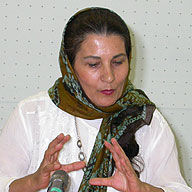An Interview with Mahvash Sheyikholeslami
Living Simply, and with Abundance

Q: What were the circumstances that led to making this piece?
MS: Previously I had visited the island (Qeshm island, where The Old Man of Hara was filmed) for a different film shoot, and I thought I’d like to shoot a film there someday. Later I visited the island again, without a budget or really knowing myself what I wanted to shoot. I tried looking around, wondering if I could find the inspiration for a film, but I thought the way things were going, I wouldn’t be able to shoot the documentary I had in mind, so I decided to leave since. And then a while later, I went to the island one more time. There I found the Hara (trees that grow in sea water) mangrove forest, and liked the idea of filming there, but I just couldn’t find the right chance. I thought I’d try going out to the ocean and rented a small boat, and set out with a guide. And it was completely the same spectacle as in the film’s opening sequence. Later I encountered the old man who appears in the film.
Q: How did you communicate with the old man?
MS: I encountered him and for the next six months I visited his house many times, and built a trusting relationship. He understood that we were serious about wanting to film his life, and we came to work together.
Q: For people in Iran, is it usual to see someone like the old man, who loves nature and lives with it in a trusting way?
MS: Unfortunately, he is out of the ordinary. Like in other countries, particularly the younger generation in Iran is becoming increasingly indifferent toward nature. When I was little I grew plants, and really loved nature. He too was very considerate toward nature and the environment around him, and he was constantly saying that recently a lot of people are catching alarming quantities of fish. Everyone could share the things in the ocean, since they belong to everyone. It seemed he was pained to see that even though people today greedily catch so many fish, they don’t share.
Q: Were there other people on the island living like the old man?
MS: There were many fishermen, but he was the only person who loved the ocean with his heart, and was content just to be there. So he had a very special existence, and turned into the film.
Q: I strongly felt the presence of natural sound within the tranquil visuals.
MS: The place where he lived is actually very quiet, without any extraneous noise. I didn’t want to use narration or spoken words, and I wanted to create a sensation of us being there with him listening to the same sounds of nature.
Q: What kind of influence did making this film have on you?
MS: Living in a more human way. We are greedy, whatever we get we want more, always more, and we run around from morning until night, which ends up making our lives more complicated. But there was something in seeing his way of living that made me think maybe humans intrinsically are meant to live like this, really simply. Living simply and with abundance. Through witnessing his life, I feel like I came into contact with something that is real philosophy, different from the kind of philosophy we read in books.
(Compiled by Hayashishita Sayo)
Interviewers: Hayashishita Sayo, Endo Nao / Interpreter: Shohreh Golparian
Photography: Yamazaki Ryo / Video: Sonobe Mamiko / 2003-10-15
